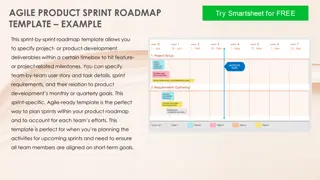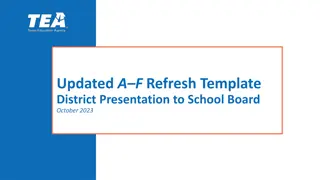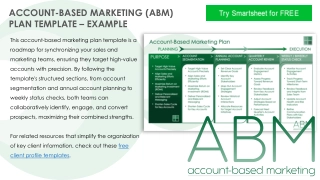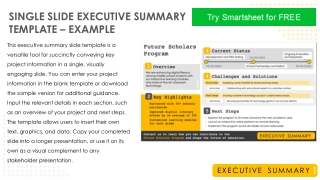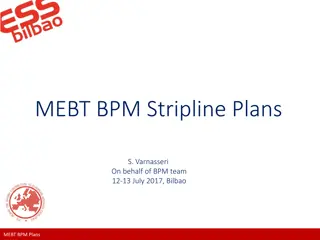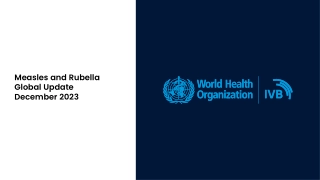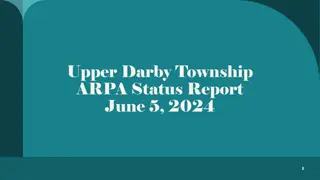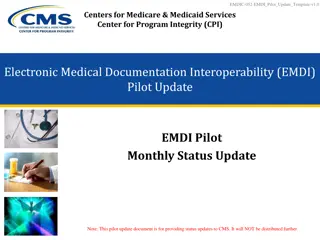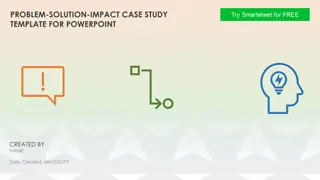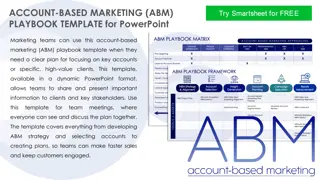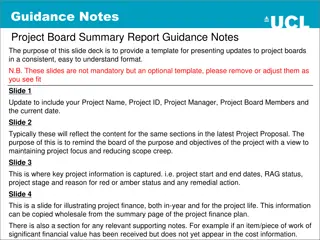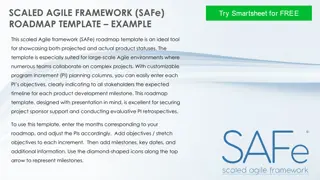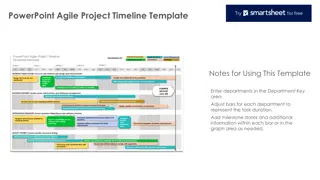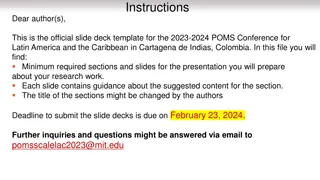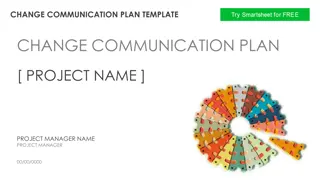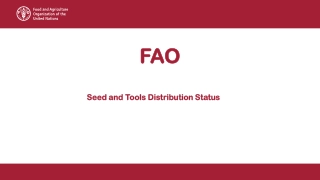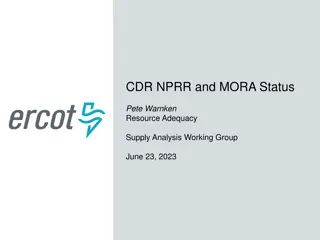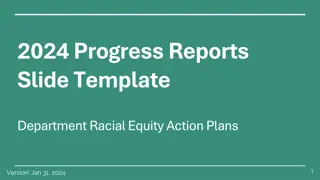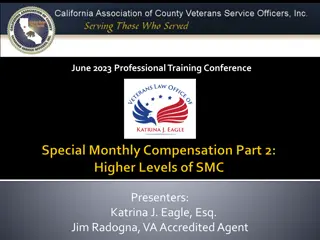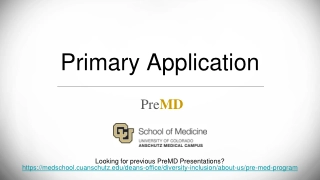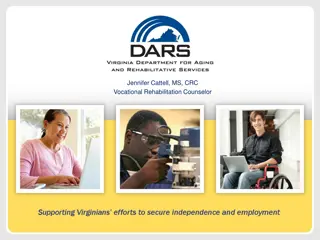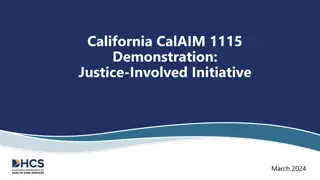Monthly Pre-Launch Status Report Template
This template is designed for tracking the progress of various elements in a pre-launch activity, including faculty selection, content development, learner resources, launch date, and overall activity status. It helps in identifying what is on track, delayed, completed, or not applicable, providing a comprehensive overview for effective project management.
Download Presentation
Please find below an Image/Link to download the presentation.
The content on the website is provided AS IS for your information and personal use only. It may not be sold, licensed, or shared on other websites without obtaining consent from the author. Download presentation by click this link. If you encounter any issues during the download, it is possible that the publisher has removed the file from their server.
Presentation Transcript
Templates and Examples
Monthly Pre-Launch Status Report Template PROVIDER NAME, GRANT ID, PROGRAM TITLE, FUNDED $ FROM ABBVIE On Track Delayed Completed Not Applicable Explain anything not on track Element Faculty Selection Faculty Confirmation Content Development Instructional Design Features Outcome Measures Developed Slide Development Learner Resources/Tools Confirmed Locations (Live Programs) - if series, please identify Slot Confirmation for Satellite Symposium Launch Date Web link (Enduring) Multi-Support Status Overall Activity Status Other
Activity Overview Slide Template LEARNING OBJECTIVES <List LOs; delete or add rows as necessary> OUTCOMES MEASURES <Insert description of measures used to assess achievement of each Learning Objective> PROVIDER INFO Title: <insert Title and Grant #> <Insert statement of the Gaps in Patient Care and HCP Competence/Performance that the activity is designed to address> PURPOSE (Gaps) <Insert statement of the Root Cause(s) that underly practice gaps that activity is designed to address> ROOT CAUSES TARGET AUDIENCE (Primary) <Insert Target Audience(s); Clearly indicate the primary target audience and list other targets (i.e., in parentheses)> ACTIVITY OVERVIEW <Insert a brief overview of the activity format(s), length, instructional features, resources, faculty, etc. used to achieve the Learning Objectives> N.B. % Anticipated = # Actual / # Anticipated ACTIVITY COMPONENT <Insert Activity Component> (e.g., Live Symposia) <Insert Activity Component> (e.g., Simulcast) <Insert Activity Component> (e.g., Enduring Online) RESOURCE(S) Actual Actual Actual Primary Targets Only Resource # Downloads Anticipated Anticipated Anticipated (% Anticipated) (% Anticipated) (% Anticipated) # Learners # Completers <Insert a brief description of each resource> # Credits Issued # Other Learners # Other Completers
EXAMPLE: Activity Overview AAA CE Group TITLE: A New And Proven Approach To Improving Adherence To Tx For Patients With Y; Grant #: 1234 LEARNING OBJECTIVES: Upon completion of this activity, learners will be able to: OUTCOMES MEASURES 1. Elicit and consider patient needs and preferences in developing Tx recommendations. 5 pre-/post case-based MCQs on best Tx options for patients with different needs Pre-post confidence in ability use Shared Decision Making Intent to change approach to involving patients in Tx selection Pre- /3 mths. Post- self-report on frequency of engaging in Shared-Decision-Making Improve patient adherence to Tx for patients with Y. More than 50% of patients stop taking medication X after 6 months. PURPOSE (Gaps) HCPs do not consistently use Shared Decision Making in selecting Tx and do not counsel patients on side effect management and adherence. ROOT CAUSES 2. Effectively counsel patients to improve adherence to Tx using a patient handout to reinforce. 2 pre-post questions on the incidence of Tx discontinuation and the consequences Number of downloads of the patient handout PRIMARY: PCPs in X who Tx Patients with Y SECONDARY: Specialists, NPs, PAs, PCPs with an interest in Y. TARGET AUDIENCE ACTIVITY OVERVIEW This 1 hour activity is a live and virtual symposium that includes 5 case studies of Shared-Decision-Making for diverse patients who suffer from Disease X. Each case requires careful consideration of patient s lifestyle, disease burden on QOL, and preferences to select an optimal Tx. The faculty also demonstrate how to effectively counsel 3 different patients about the critical importance of long-term adherence and answer their questions. Learners are given a downloadable patient guide to use in their counseling. ACTIVITY COMPONENT Live Symposia Simulcast Totals RESOURCE(S) Actual Actual Actual Primary Targets Only Resource # Downloads Anticipated Anticipated Anticipated (% Anticipated) (% Anticipated) (% Anticipated) 500 445 (89%) 300 350 (117%) 800 795 (99%) # Learners 375 370 (99%) 250 245 (98%) 625 651 (104%) # Completers 200 220 (110%) 100 120 (120%) 300 340 (113%) # Credits Issued Patient Guide 150 75 134 (179%) 100 150 (150%) 175 284 (162%) # Other Learners 70 100 (143%) 75 72 (96%) 145 172 (119%) # Other Completers
EXAMPLE: Outcomes Data OUTCOMES MEASURES LO# 1: Elicit and consider patient needs and preferences in developing Tx recommendations. 5 pre-/post case-based MCQs on best Tx options for patients with different needs (t-test) Pre-post confidence in ability to use Shared Decision Making (t-test) Intent to change approach to involving patients in Tx selection Pre-/3 months post self-report on frequency of engaging in Shared Decision Making (1=Rarely, 5=Almost Always) (t-test) 01 02 03 Average Scores on 5 Pre & Post Test Questions Mean Confidence in Use of SDM Pre and Post Activity (5=HIGH, 1=LOW) Intent to Change 01 02 PCPs (n= 42) 03 34/42 commented (free text) that they will be more likely to ask about patient preferences and use Shared Decision Making in developing Tx plans 5 90 12% 80 4 70 60 3 25% 42% 50 40 2 30 20 1 10 0 0 PCPs (140) Specialists (99) Pre Allied Health(86) PCPs (140) Specialists (99) Pre Allied Health(86) Post Post Highlights: Highlights: The primary target improved by 42% Specialists had a high baseline (NS) Allied Health Improved by 25% Confidence improved significantly for PCPs and Allied Health (p<.05), but not for Specialists who had a high level of confidence at the outset.
EXAMPLE: Summary of Qualitative Learner Comments # of THEMES Representative Comments/Questions Comments (n=55) Key Insights for Future Activities Comorbidities, Tx and Dosing How would you dose in patients with< X, Y, Z> ? Would you down dose for a patient with <X>? What if the patient was on <X> treatment? Can resistance develop? More cases addressing complex patients 20 Screening Tools Which of the screening tools is easiest to use in practice? I prefer to use the X screening tool as its fastest. How can a 3 questions screening tool be reliable? Provide a recommendation and demonstration of high efficiency, high sensitivity screening tool Email it to participants 12 Cost and Access Is it cost effective to use imaging techniques for this purpose? I don t believe imaging will be reimbursed? Include information on cost effectiveness and reimbursement 7 Use of Cases Cases were a great idea Loved it Cases were too easy my patients are typically much more complex More diverse case would have been useful More cases addressing complex patients 7 Faculty/ Presentation Faculty were excellent presenters explained well/ were dynamic Use these faculty again 5 Technical Challenges Improve user-access testing prior to the event Couldn t access the resources Technical problems prevented seeing first 10 minutes. 4 Other No time to <Insert examples> 4 If AI tools are used, they must be cited
EXAMPLE: Satisfaction Data CME Quality Indicator based on a validated measure (J Contin Educ Health Prof. 2007; 27:173 this is one of three validated tools) Rating* (n) * 7=completely, 1= Minimally Learning Objectives met 6.5 (425); SD = 1.5 Addressed my most pressing questions 5.0 (390); SD = 2.0 Provided competencies identified by my specialty 4.75 (380); SD = 1.2 Provided clear evidence to support content 6.4 (425); SD = 1.9 Included opportunities to learn interactively from faculty and participants 6.8 (410); SD = 0.9 Provided me with supporting materials or tools for my office 6.6 (425); SD = 0.9 Included opportunities to solve patient cases 5.8 (390); SD = 1.3 Allowed me to assess what I had learned 5.75 (420); SD = 1.5 Translated trial data to patients I see in my practice N/A Addressed barriers to my optimal patient management 6.8 (425); SD = 1.4 99% of post-activity respondents (n=325) indicated that the activity provided fair and balanced content free from commercial bias
EXAMPLE: Executive Summary Report AAA CE Group TITLE: A New And Proven Approach To Improving Adherence To Tx For Patients With Y; Grant #: 1234 LEARNING OBJECTIVES: Upon completion of this activity, learners will be able to: OUTCOMES MEASURES 1. Elicit and consider patient needs and preferences in developing Tx recommendations. 5 pre-/post case-based MCQs on best Tx options for patients with different needs Pre-post Confidence in ability use shared decision making Intent to change approach to involving patients in Tx selection Pre- /3 mths. Post- self-report on frequency of engaging in Shared-Decision-Making Improve patient adherence to Tx for patients with Y. More than 50% of patients stop taking medication X after 6 months. PURPOSE (Gaps) HCPs do not consistently use Shared-Decision-Making in selecting Tx and do not counsel patients on side effect management and adherence. ROOT CAUSES 2. Effectively counsel patients to improve adherence to Tx using a patient handout to reinforce. 2 pre-post questions on the incidence of Tx discontinuation and the consequences Number of downloads of the patient handout PRIMARY: Specialists in X who Tx patients with Y SECONDARY: NPs, PAs, PCPs with an interest in Y Anticipated # of Learners TARGET AUDIENCE INSTRUCTUAL DESIGN METHODOLOGY - include pre-disposing tactics, describe engagement strategies used, enabling activities used to achieve each LO, and use of any reinforcing activities: This 1 hour activity is a live and virtual symposium that includes 5 case studies of Shared-Decision-Making for diverse patients who suffer from Disease X. Each case requires careful consideration of patient s lifestyle, disease burden on QOL, and preferences to select an optimal Tx. The faculty also demonstrate how to effectively counsel 3 different patients about the critical importance of long-term adherence and answer their questions. Learners are given a downloadable patient guide to use in their counselling. ACTUAL OVERALL TARGET AUDIENCE PARTICIPATION OVERALL PROGRAM OUTCOMES MEANINGFUL INSIGHTS Mean Confidence in Use of SDM Pre and Post Activity (5=HIGH, 1=LOW) Average Scores on 5 Pre & Post Test Questions Community Practice LIVE and ENDURING US Learners (545) This activity led to improved patient adherence, increased use of Shared Decision Making, and the use of a resource to counsel patients. PCPs in community settings benefited the most. This activity impacted approximately 1200 patients per year in x disease state.* Completers (475) Completion Rate PRIMARY TARGETS 12% 25% 42% 90 6 MDs 250 230 92% 60 3 PAs/NPs 150 120 80% 30 0 0 Academic Practice LIVE AND ENDURING - US PCPs (427) Specialists (300) Allied Health (262) PCPs (427) Specialists Allied (300) Health (262) MDs 100 90 90% Pre Post Pre Post PAs/NPs 45 35 78% * # unique patients with disease seen monthly X # completers in the primary target audience who demonstrated improved competence/performance
EXAMPLE: Delineation of Learner Data Breakout by Audiences, Formats, Regions, Practice Setting, Years in Practice 0ct. 1 Dec. 30th, 2023 LIVE - US ONLINE - US Completion Rate 71% 70% 71% Resource Downloads 300 580 Completion Rate 91% 79% 87% Resource Downloads 25 36 PRIMARY TARGETS Learners Completers PRIMARY TARGETS Learners Completers PCPs PAs/NPs TOTAL 3500 3500 545 2500 2460 4960 PCPs PAs/NPs TOTAL 350 195 545 320 155 475 SECONDARY TARGETS SECONDARY TARGETS Specialists Nurses Pharm Other TOTAL Specialists Nurses Pharm Other TOTAL 200 20 10 30 260 80 18 9 25 132 40% 90% 90% 83% 51% 0 2 0 0 750 680 200 50 1680 300 330 50 40 720 40% 49% 25% 80% 43% 50 100 5 6 Community Practice LIVE US Completers - Years in Practice (Live & Online) PRIMARY TARGETS Learners (545) Completers (475) Completion Rate PRIMARY TARGETS 0-5 Yrs 6-10 Yrs >10 Years TOTAL PCPs 250 230 92% PAs/NPs 150 120 80% PCPs 1100 1000 720 2820 Academic Practice LIVE - US PAs/NPs 1390 675 485 2550 PCPs 100 90 90% TOTAL 2490 1675 1205 5370 PAs/NPs 45 35 78%
EXAMPLE: Outcomes Data OUTCOMES MEASURES LO# 1: Elicit and consider patient needs and preferences in developing Tx recommendations. 5 pre-/post case-based MCQs on best Tx options for patients with different needs (t-test) Pre-post confidence in ability to use Shared Decision Making (t-test) Intent to change approach to involving patients in Tx selection Pre-/3 months post self-report on frequency of engaging in Shared Decision Making (1=Rarely, 5=Almost Always) (t-test) 01 02 03 04 Average Scores on 5 Pre & Post Test Questions Intent to Change Mean Confidence in Use of SDM Pre and Post Activity (5=HIGH, 1=LOW) 01 02 PCPs (n= 67) 03 53/67 commented (free text) that they will be more likely to ask patient preferences and use Shared Decision Making in developing Tx plans 90 5 4 60 3 2 30 1 Pre-/3 Months Post Self-Report (SDM Use) 04 0 0 PCPs (427) Specialists (300) Allied Health (262) PCPs (427) Specialists (300) Allied Health (262) PCPs (40) Pre Post Pre Post 6 4 Highlights: Highlights: 2 0 The primary target improved by 42% Specialists had a high baseline (NS) Allied Health Improved by 25% Confidence improved significantly for PCPs and Allied Health (p<.05), but not for Specialists who had a high level of confidence at the outset. Pre 3 mos Post Highlights: Statistics No significant change: PCPs believed they were using Shared Decision Making before the activity P<.05 for PCPs and Allied Health (See Appendix for Question Details)
EXAMPLE: Final Insights and Lessons Learned MAJOR OUTCOMES INSTRUCTIONAL DESIGN AND TARGET AUDIENCE OUTCOMES MEASURES The activity significantly improved PCP and Allied Health: 1. Ability to elicit and consider patient needs and preferences in developing Tx recommendations (as measured by average scores on 5 case-based questions) 2. Confidence in doing so The case-based method and tools are good instructional approach for this topic for PCPs. Replicate this for PCPs. Consider a different activity specifically targeting Allied Heath as they did not reach the same level of achievement on post-test as PCPs. Specialists did not benefit significantly from this activity as evidenced by their high average scores on pre-tests and confidence. Develop more difficult cases and selectively target specialists in different activities. Self-reported use of Shared Decision Making did not increase after the activity, as the large majority reported they were using SDM effectively on pre-assessment. Explore different more sensitive ways to assess actual use of SDM before and after the activity. Analysis of the individual pre-post questions revealed that 2 of the 5 were very easy 95% correct on pre- test. Pre-test questions to eliminate those that are too easy. The activity could have benefitted from more cases with a wider variety of comorbidities and complex patients.



